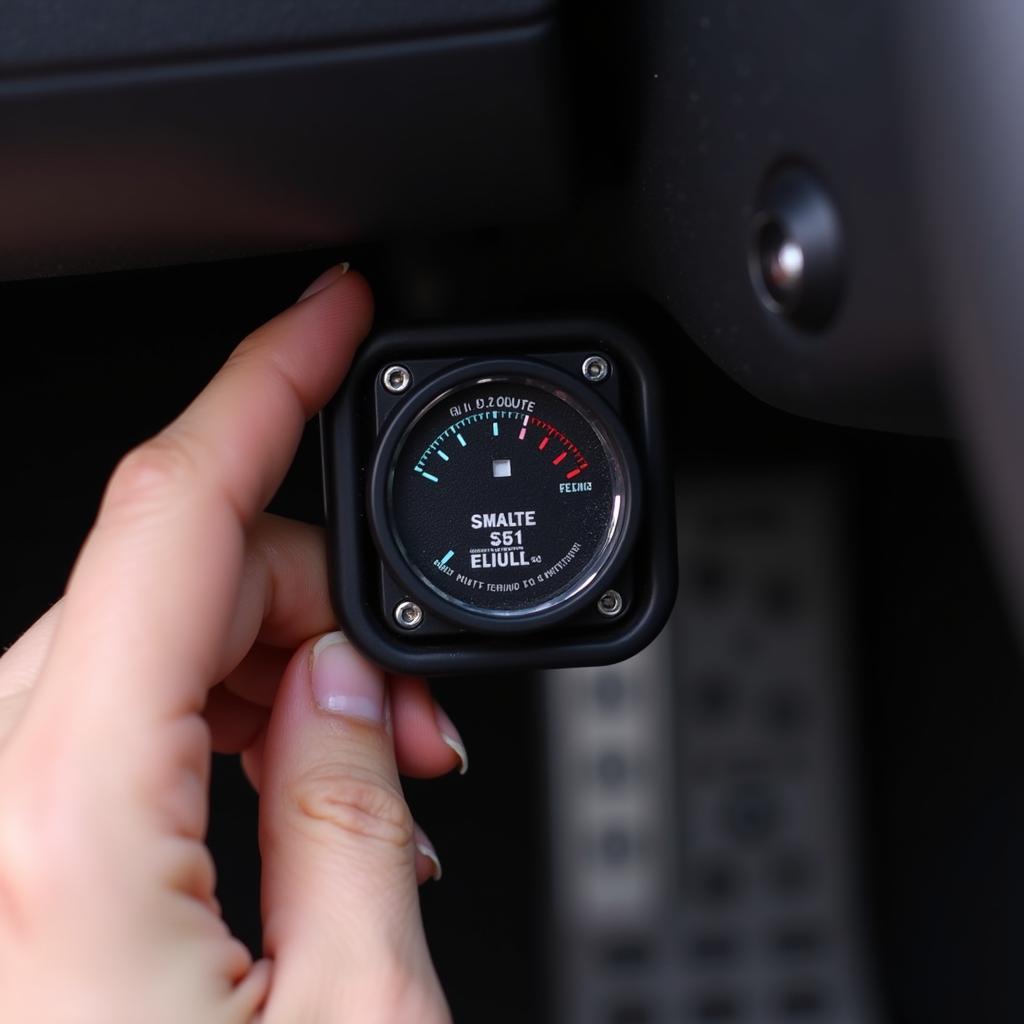The heart-stopping moment when a dashboard warning light illuminates can send chills down any driver’s spine. Among these alerts, the brake warning light is one of the most crucial, demanding immediate attention. But what does the brake warning light warn the driver of? This comprehensive guide delves into the depths of this safety-critical indicator, empowering you with the knowledge to navigate such situations confidently.
Deciphering the Warning: Common Causes of Illumination
The brake warning light, typically depicted as a circled exclamation mark within parentheses or a “BRAKE” inscription, serves as your vehicle’s primary communication channel regarding braking system anomalies. While its illumination can induce panic, understanding its potential triggers is crucial for effective troubleshooting.
Here’s a breakdown of the common culprits:
- Low Brake Fluid: The most frequent offender, low brake fluid, often signals a leak within the system.
- Worn Brake Pads: Designed with wear indicators, brake pads trigger the warning light when they thin out, demanding replacement.
- Faulty Brake Light Switch: This switch, responsible for activating your brake lights upon pedal depression, can malfunction, leading to a lit warning light.
- ABS Issues: Modern vehicles equipped with Anti-lock Braking Systems (ABS) may illuminate the brake warning light if a sensor or module within the system malfunctions.
- Parking Brake Engagement: While seemingly obvious, accidentally leaving the parking brake partially engaged can trigger the light, often accompanied by a secondary indicator.
Ignoring the Warning: The Perils of Neglecting the Light
Ignoring a glowing brake warning light is akin to playing a dangerous game with your safety and that of others on the road. Driving with a compromised braking system significantly increases the risk of accidents, leading to severe consequences.
Here’s why you should never ignore this warning:
- Increased Stopping Distance: Low brake fluid or worn brake pads directly impact your vehicle’s ability to stop efficiently, significantly increasing the distance required to come to a complete halt.
- Complete Brake Failure: In extreme scenarios, neglecting a persistent brake warning light can result in complete brake failure, rendering your vehicle uncontrollable.
- Expensive Repairs: What might have started as a minor leak or worn pads can escalate into a major, expensive repair if ignored for prolonged periods.
What to Do When the Brake Warning Light Turns On
The illumination of the brake warning light necessitates prompt action. While panic is never the solution, adopting a calm and collected approach is paramount.
Here’s a step-by-step guide:
- Safely Move to the Side: Engage your hazard lights and carefully maneuver your vehicle off the road and away from traffic.
- Check Your Parking Brake: Ensure your parking brake is fully disengaged. If the light persists, proceed to the next step.
- Inspect Your Brake Fluid Level: With the engine off, locate your brake fluid reservoir (refer to your owner’s manual) and check the fluid level. If it’s low, adding brake fluid might temporarily address the issue, but seeking professional inspection for leaks is crucial.
- Avoid Driving Further: If the fluid level is adequate or you suspect other issues, refrain from driving further. Contact a qualified mechanic or tow your vehicle to a trusted repair shop for a thorough diagnosis.
Remote Diagnostics and Software Solutions: The Future of Automotive Repair
In our technologically advanced era, remote diagnostics and software solutions are revolutionizing the automotive repair landscape. These advancements offer convenience and efficiency in addressing brake warning light issues.
Remote diagnostics enable skilled technicians to remotely access your vehicle’s computer system, retrieve diagnostic trouble codes, and analyze data in real-time. This technology expedites the diagnosis process, pinpointing the root cause of the issue without requiring your physical presence at a repair shop.
Software solutions play a pivotal role in addressing software-related glitches that might trigger the brake warning light. Over-the-air software updates, facilitated by manufacturers, can rectify software bugs or compatibility issues that may be affecting your braking system.
Preventive Measures: Keeping Your Braking System in Top Shape
Just like any other critical component of your vehicle, your braking system thrives on regular maintenance and care. Adopting a proactive approach to brake health can significantly reduce the likelihood of encountering the dreaded brake warning light.
Here are some preventative measures to keep your braking system in peak condition:
- Adhere to Scheduled Brake Inspections: Follow your manufacturer’s recommended maintenance schedule for brake inspections.
- Be Attentive to Changes in Brake Pedal Feel: Pay close attention to any unusual sensations in your brake pedal, such as sponginess, hardness, or vibrations.
- Listen for Unusual Noises: Be alert for any unusual noises emanating from your brakes, such as grinding, squeaking, or clicking.
- Avoid Riding Your Brakes: Prolonged or aggressive braking generates excessive heat, accelerating brake pad wear.
- Choose Quality Brake Pads: When it’s time for replacement, opt for high-quality brake pads from reputable brands.
Expert Insight:
“Many drivers underestimate the critical role of brake fluid,” says automotive engineer Sarah Thompson. “It’s not just about the level, but also the quality. Over time, brake fluid absorbs moisture, reducing its effectiveness and potentially leading to corrosion within the system. Regular flushes are crucial for maintaining optimal braking performance.”
Conclusion: Prioritizing Your Safety on the Road
The brake warning light serves as a critical line of communication between your vehicle and you, the driver. Never ignore its illumination. Understanding its implications and taking swift action is paramount for ensuring your safety and the well-being of others on the road. By adhering to preventive measures, staying informed about advancements in remote diagnostics and software solutions, and seeking timely professional assistance when needed, you can navigate the roads confidently, knowing your braking system is in optimal condition.
Frequently Asked Questions (FAQs)
1. Can I drive a short distance with the brake warning light on?
It’s strongly advised against driving any distance with the brake warning light illuminated. Even a short drive poses significant safety risks.
2. How much does it cost to fix a brake warning light issue?
The repair cost varies depending on the underlying cause. A simple brake fluid top-up might cost a few dollars, while extensive repairs like caliper replacement can range from hundreds to thousands of dollars.
3. How often should I change my brake fluid?
Refer to your vehicle’s owner’s manual for specific recommendations. Generally, brake fluid flushes are recommended every 2-3 years or as per the manufacturer’s guidelines.
4. Can I check my brake fluid level myself?
Yes, you can check the brake fluid level visually by locating the reservoir and inspecting the fluid level markings. However, it’s recommended to have a qualified mechanic diagnose any issues.
5. Are there different types of brake warning lights?
While the standard brake warning light is universal, some vehicles might have additional indicators for ABS malfunctions or parking brake engagement. Consult your owner’s manual for specific light meanings.
6. Can a software update fix my brake warning light problem?
Yes, in some cases, software updates can address software-related glitches that trigger the brake warning light, particularly in modern vehicles with complex electronic systems.
7. What is the difference between the brake warning light and the ABS light?
The brake warning light indicates a general braking system issue, while the ABS light specifically signals a problem with the Anti-lock Braking System.
Remember, your safety on the road is paramount. Address any brake warning light concerns promptly and responsibly.


